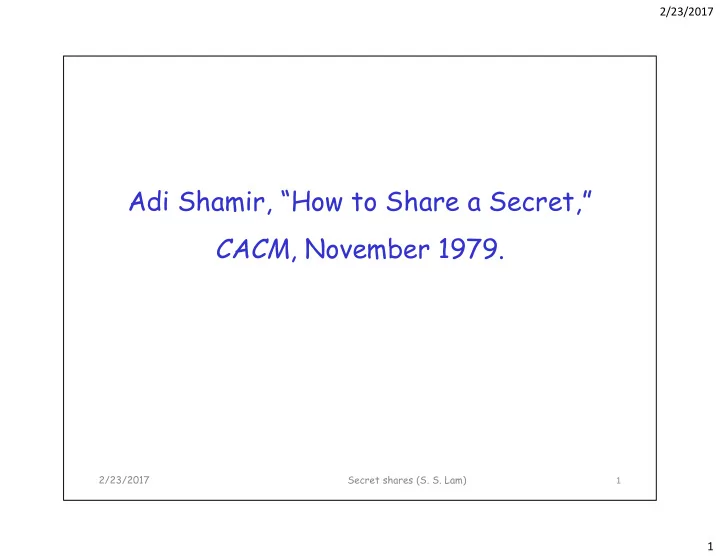

2/23/2017 Adi Shamir, “How to Share a Secret,” CACM November 1979 CACM , November 1979. 2/23/2017 Secret shares (S. S. Lam) 1 1
2/23/2017 How to share a secret [Shamir 1979] ( K N ) th ( K , N ) threshold scheme h ld h Secret D is represented by N pieces D 1 , …, D N o D is easily computable from any K or more pieces o D is easily computable from any K or more pieces o D cannot be determined with knowledge of K-1 or fewer pieces Tradeoff between reliability and security o Reliability: D can be recovered even if N-K pieces are destroyed are destroyed o Security: foe can acquire K-1 pieces and still cannot uncover D Tradeoff between safety and convenience o Example—A company’s checks must be (digitally) signed by three executives signed by three executives 2/23/2017 Secret shares (S. S. Lam) 2 2
2/23/2017 (K, N) scheme by polynomial interpolation Given K points in 2-dimensional space, (x 1 , y 1 ), … , (x K , y K ), with distinct x i ’s, ( K y K ) i o there is one and only one polynomial q(x) of degree K-1 such that q(x i )=y i for all i. Let the secret D be a number. Randomly select a K-1 degree polynomial Randomly select a K degree polynom al 1 ( ) ... where K − q x a a x a x a D = + + + = 0 1 1 0 K − Compute N values of q(x) (1), ..., (1), ..., ( ), ..., ( ), ..., ( ( ) ) D D q q D D q i q i D D q N q N = = = 1 1 i i N N 2/23/2017 Secret shares (S. S. Lam) 3 3
2/23/2017 Scheme by polynomial interpolation (cont.) y p y p ( ) Given any subset of K of the (i, D i ) pairs, the coefficients of the unique q(x) can be found ffi i t f th i ( ) b f d by interpolation (such as, using the interpolation polynomial in the Lagrange form (such as using the interpolation polynomial in the Lagrange form or by solving a set of K linear equations with K unknowns) Th The secret D is q(0) t D i (0) Shamir’s claim: Knowledge of just K-1 of the Sh i ’ l i K l d f j t K 1 f th (i, D i ) pairs provides no information about D 2/23/2017 Secret shares (S. S. Lam) 4 4
2/23/2017 Explanation of the previous claim Consider the special case of a finite field GF(p) where p d h l f f f ld GF( ) h is a large prime number larger than both D and N o The coefficients, a 1 , …, a K-1 , are randomly chosen from a , 1 , , K 1 , y uniform distribution over [0, p) o D 1 , …, D N are computed modulo p for distinct x values chosen from [0, p) [ p) Suppose K-1 of the (x i , D i ) pairs are revealed to a foe. For each candidate value D’ in [0 p) for the secret the For each candidate value D in [0, p) for the secret, the foe can construct one and only one polynomial q’(x) of degree K-1 such that q’(0) = D’ and q’(x i )=D i for the K-1 revealed pieces revealed pieces. o By construction, all possible polynomials are equally likely. So there is nothing the foe can deduce about the true value of D value of D. 2/23/2017 Secret shares (S. S. Lam) 5 5
2/23/2017 Useful properties Si Size of each piece D i is not larger than size of f h i D i t l th i f secret D When K is kept fixed, D i pieces can be When K is kept fixed D pieces can be dynamically added or “deleted” Individual D i pieces can be changed without changing the secret D g g o Such changes enhance security over the long term. o How? Use a new polynomial with the same a value (D) Use a new polynomial with the same a 0 value (D) VIPs can be given more than one D i pieces 2/23/2017 Secret shares (S. S. Lam) 6 6
2/23/2017 Application to mobile ad hoc networks Jiejun Kong, Petros Zerfos, Haiyun Luo, Songwu Lu, Lixia Zhang, “Providing Robust and Ubiquitous Security Support for Zhang, Providing Robust and Ubiquitous Security Support for Mobile Ad-Hoc Networks,” Proceedings IEEE ICNP 2001. Comment - Shamir’s method requires a secure and trusted server. This paper attempts to apply Shamir’s method to mobile ad hoc networks which do not have access to a secure and trusted server when deployed in the field. The proposed d d h d l d h f ld h d solution is interesting but incomplete. 2/23/2017 Secret shares (S. S. Lam) 7 7
2/23/2017 The end The end 2/23/2017 Secret shares (S. S. Lam) 8 8
Recommend
More recommend